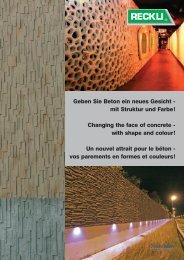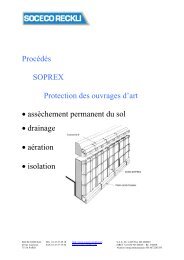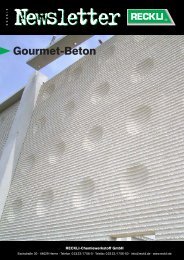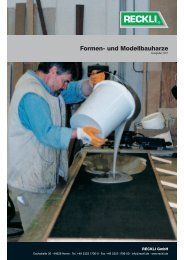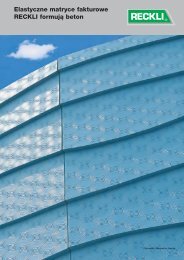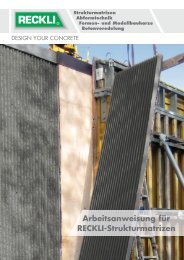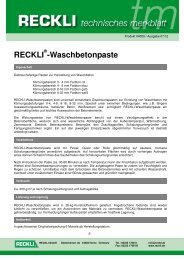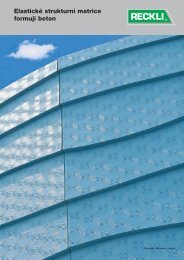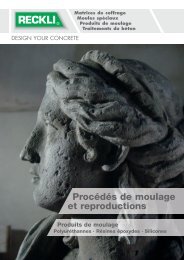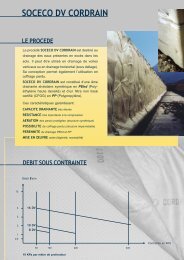PDF Download - RECKLI GmbH
PDF Download - RECKLI GmbH
PDF Download - RECKLI GmbH
You also want an ePaper? Increase the reach of your titles
YUMPU automatically turns print PDFs into web optimized ePapers that Google loves.
Abformtechnik<br />
Moulding and Reproduction Techniques<br />
Procédé de moulage
Sie sind<br />
� Archäologe<br />
� Bastler<br />
� Bühnenbildner<br />
� Denkmalpfleger<br />
� Designer<br />
� Formenbauer<br />
� Former<br />
� Kerzengießer<br />
� Künstler<br />
� Kulissenbauer<br />
� Kunsthandwerker<br />
� Maskenbildner<br />
� Modellbauer<br />
� Modelleur<br />
� Museumswerkstatt<br />
� Präparator<br />
� Schausteller<br />
� Stuckateur<br />
� Theaterwerkstatt<br />
� Tüftler<br />
� Zirkuswerkstatt<br />
dann sind Sie unser Partner.<br />
Wir sind Ihr<br />
Abformspezialist<br />
und liefern:<br />
� Polyurethane<br />
� Epoxide<br />
� Silikone<br />
� Trennmittel<br />
� Füllstoffe<br />
für:<br />
� das Modell<br />
� die Form<br />
� das Replikat.<br />
Auf den folgenden Seiten finden Sie<br />
Anwendungsbeispiele für unsere Produkte.<br />
Technische Merkblätter mit Beschreibungen<br />
der Materialeigenschaften, Prüfzeugnisse,<br />
Übersichtstabellen, DIN-Sicherheitsdatenblätter<br />
und Preislisten haben wir<br />
für Sie in separaten Produktmappen<br />
zusammengestellt.<br />
Wir bedanken uns bei allen Kunden, die<br />
dazu beigetragen haben, dass dieser<br />
Katalog erstellt werden konnte.<br />
2<br />
These are<br />
our partners<br />
� Archaeologist<br />
� Artisan<br />
� Artist<br />
� Candle Makers<br />
� Cinematic Special Effects Studio’s<br />
� Circus Workshops<br />
� Do-it-yourselfer<br />
� Engineering Prototypes<br />
� Fibrous Plasterers<br />
� Make-up Artist<br />
� Mode Maker<br />
� Modeller<br />
� Monument Restorers<br />
� Mouldmakers<br />
� Museum Workshop<br />
� Pattern Makers<br />
� Scenemakers<br />
� Set Designers<br />
� Taxidermist<br />
� Theatre Workshops<br />
We are your<br />
specialist moulding manufacturer<br />
and supply:<br />
� Polyurethanes<br />
� Epoxies<br />
� Silicones<br />
� Release agents<br />
� Fillers<br />
for:<br />
� The Model<br />
� The Mould<br />
� The Reproduction<br />
On the following pages you will find application<br />
examples for our products.<br />
We have separate product brochures available<br />
with technical pamphlets giving information<br />
on the materials properties, test<br />
certificates, suitability survey tables, safety<br />
data sheets according to DIN standards<br />
(German Industrial Norm) and price lists.<br />
We thank all customers who have contributed<br />
to this catalogue.<br />
Vous êtes:<br />
� Accessoiriste<br />
� Archéologue<br />
� Artisan<br />
� Artiste<br />
� Décorateur<br />
� Décorateur de théâtre<br />
� Designer<br />
� Fabricant de bougies<br />
� Fondeur d'art<br />
� Forain<br />
� Modeleur<br />
� Mouliste<br />
� Muséographe<br />
� Naturaliste, taxidermiste<br />
� Sculpteur<br />
� Staffeur<br />
� Statuaire<br />
� Tailleur de pierre<br />
Vous faites alors partie de nos partenaires.<br />
Nous sommes<br />
des spécialistes du moulage<br />
et fournisseurs de:<br />
� Polyuréthannes<br />
� Résines époxydes<br />
� Silicones<br />
� Démoulants<br />
� Charges et produits annexes<br />
pour:<br />
� le modèle<br />
� le moule<br />
� la reproduction<br />
Sur les pages suivantes, figurent des<br />
exemples d'applications de nos produits.<br />
Les notices techniques, les directions<br />
d'emploi, description des produits, les<br />
fiches de sécurité et les listes de prix sont<br />
disponibles, séparément, sur demande.<br />
Nous remercions tous les clients grâce<br />
auxquels il nous a été possible de réaliser<br />
cette brochure.
Kämpfende Bisons<br />
Original: Bronze, Form: <strong>RECKLI</strong>-SI-Abformpaste HR-N,<br />
Stützform: <strong>RECKLI</strong>-Epoxi-GF-Spachtel,<br />
Replikat: <strong>RECKLI</strong>-Bauharz EP, gefüllt mit<br />
<strong>RECKLI</strong>-Füller C, Polychromierung<br />
Fighting Bisons<br />
Original: Bronze, Elastic mould: <strong>RECKLI</strong> Si-Mould Paste<br />
HR-N, Carrier/Support case: <strong>RECKLI</strong> Epoxy GF-Filler,<br />
Reproduction: <strong>RECKLI</strong> Construction Resin EP, filled by<br />
<strong>RECKLI</strong> Filler C, coloured by polychromizing<br />
Combat de bisons<br />
Original: bronze, Moule: Silicone <strong>RECKLI</strong> HR-N<br />
Ossature: Masticoque <strong>RECKLI</strong> Epoxi GF,<br />
Reproduction: <strong>RECKLI</strong> Epoxi EP additionnée de<br />
Charge <strong>RECKLI</strong> C, Patine<br />
Römisches Weinschiff aus Neumagen-Dhron<br />
Original: Sandstein, Form: <strong>RECKLI</strong>-PUR-Elastomer thix<br />
und -thix schwarz, Trennmittel: <strong>RECKLI</strong>-Formenwachs,<br />
Stützform: <strong>RECKLI</strong>-Epoxi-GF-Spachtel, Replikate: mehrere<br />
Abgüsse aus Beton<br />
Roman Wine Ship from Neumagen-Dhron<br />
Original: Sandstone, Elastic mould: <strong>RECKLI</strong> PUR-<br />
Elastomer thix and -thix black, Release agent: <strong>RECKLI</strong><br />
Mould Wax, Carrier/Support case: <strong>RECKLI</strong> Epoxy GF-<br />
Filler, Reproductions: Several casts in concrete<br />
Navire romain à Neumagen-Dhron<br />
Original: grès, Moule: Elastomère <strong>RECKLI</strong> PUR Thix et<br />
Thix noir, Démoulant: cire de décoffrage <strong>RECKLI</strong>,<br />
Ossature: Masticoque <strong>RECKLI</strong> Epoxi GF,<br />
Reproduction: béton<br />
3
Kajak<br />
Laminat aus eingefärbtem <strong>RECKLI</strong>-Epoxi-OH und<br />
<strong>RECKLI</strong>-Epoxi-WST / Glasgewebematten,<br />
Länge: 2,35 m, Einsatz: Wildwasserfahrten<br />
Kayak<br />
Laminate of coloured <strong>RECKLI</strong> Epoxy OH and<br />
<strong>RECKLI</strong> Epoxy WST / glass fibre mat,<br />
length: 2.35 m, use: white water racing and slalom<br />
Kayak<br />
Stratifié à base de <strong>RECKLI</strong> Epoxi OH et<br />
<strong>RECKLI</strong> Epoxi WST renforcé de toile de verre.<br />
Longueur 2,35 m, Utilisé en torrents.<br />
4<br />
Filmkulisse aus<br />
„Die unendliche Geschichte Teil III“<br />
Polystyrolschaum und Spanplatten, beschichtet mit<br />
<strong>RECKLI</strong>-Bauharz EP, eingefärbt mit löslichem Farbstoff<br />
Movie Scenery of<br />
”The Never Ending Story Part III”<br />
Polystyrene foam and chipboard coated with<br />
<strong>RECKLI</strong> Construction Resin EP, coloured by a soluble<br />
colouring.<br />
Décors du film «L’histoire sans fin N°3»<br />
Polystyrène expansé et bois aggloméré recouverts de<br />
<strong>RECKLI</strong> Epoxi EP colorée.<br />
Abformung eines toten Zwergwales<br />
Der tote Wal wurde in seiner natürlichen<br />
Schwimmbewegung eingefroren und im gefrorenen<br />
Zustand mit <strong>RECKLI</strong>-Si-Gießmasse 20 zuzüglich<br />
<strong>RECKLI</strong>-Si-Verdicker flüssig K abgeformt. Schwanz-,<br />
Rücken- und Seitenflossen wurden solitär abgeformt.<br />
Als Stützform dienten <strong>RECKLI</strong>-Epoxi-GF-Spachtel und<br />
Gips. Das Replikat wurde in Laminiertechnik gefertigt.<br />
Hierfür kamen <strong>RECKLI</strong>-Epoxi-OH, <strong>RECKLI</strong>-Epoxi-WST<br />
und <strong>RECKLI</strong>-Epoxi-M mit Glasfasermatten zum<br />
Einsatz. Das Replikat wurde mit Ölfarben und Airbrush<br />
koloriert und mit <strong>RECKLI</strong>-Polierwachs poliert.<br />
Moulding of a Dead Dwarf Whale<br />
The dead whale was frozen in his natural swimming<br />
movement. In this state it was moulded with <strong>RECKLI</strong><br />
Si-Compound 20 plus <strong>RECKLI</strong> Si-Thickener Liquid K.<br />
Tail, back and side flippers were moulded separately.<br />
For the support mould <strong>RECKLI</strong> Epoxy GF-Filler and<br />
Plaster were used. The reproduction was manufactured<br />
using laminating technique. <strong>RECKLI</strong> Epoxy-OH,<br />
<strong>RECKLI</strong> Epoxy-WST and <strong>RECKLI</strong> Epoxy-M with glass<br />
fibre mats were used. The reproduction was coloured<br />
by oil colours and airbrush and polished with <strong>RECKLI</strong><br />
Polishing Wax.<br />
Moulage d'un Epaulard<br />
L’épaulard a été congelé dans une attitude de nage<br />
naturelle et moulé à l’aide de Silicone <strong>RECKLI</strong> C20<br />
épaissi avec l'agent thixotropant K. Les nageoires<br />
caudale et ventrale été moulées séparément.<br />
L’ossature support du moule est constituée de plâtre<br />
et de Masticoque <strong>RECKLI</strong> Epoxi GF. La reproduction a<br />
été peinte à l’aérographe et polie à la policire <strong>RECKLI</strong>.
Mops<br />
Original: Bronze<br />
Form: <strong>RECKLI</strong>-PUR-Elastomer thix und -thix schwarz<br />
Stützform: <strong>RECKLI</strong>-Epoxi-GF-Spachtel<br />
Replikat: <strong>RECKLI</strong>-Epoxi-OH und<br />
<strong>RECKLI</strong>-Bauharz EP „schnell“, verstärkt durch kurzgeschnittene<br />
Glasfasern, Schwenkgusstechnik,<br />
Kolorierung: mit Bronze und Patinafarben<br />
Pug Dog<br />
Original: Bronze<br />
Elastic mould: <strong>RECKLI</strong> PUR-Elastomer thix and<br />
-thix black<br />
Carrier/Support case: <strong>RECKLI</strong> Epoxy GF Filler<br />
Reproduction: <strong>RECKLI</strong> Epoxy OH and<br />
<strong>RECKLI</strong> Construction Resin EP ”rapid”, reinforced by<br />
short-cut glass fibres, centrifugal casting,<br />
Colouring: by bronze and patina colours<br />
Bouledogue<br />
Original: bronze<br />
Moule: Elastomere <strong>RECKLI</strong> PUR Thix et Thix noir<br />
Ossature: Masticoque <strong>RECKLI</strong> Epoxi GF<br />
Reproduction: <strong>RECKLI</strong> Epoxi OH, <strong>RECKLI</strong> Epoxi EP<br />
rapide renforcée de fibre de verre coupée. Coulage<br />
par centrifugation.<br />
Coloration: patine bronze.<br />
5
Edenkobener Kirchenglocke von 1624<br />
Original: befindet sich im Historischen Museum der<br />
Pfalz, Speyer<br />
Form: <strong>RECKLI</strong>-Si-Gießmassen 10/15 und 20,<br />
<strong>RECKLI</strong>-Abformpaste HR-N<br />
Stützform: <strong>RECKLI</strong>-Epoxi-GF-Spachtel<br />
Trennmittel: <strong>RECKLI</strong>-Formenwachs und<br />
<strong>RECKLI</strong>-Si-Trennlack<br />
Replikat: <strong>RECKLI</strong>-Injektionsharz EP,<br />
<strong>RECKLI</strong>-Bauharz EP „schnell“, gefüllt mit <strong>RECKLI</strong>-<br />
Füller C und <strong>RECKLI</strong>-Stellmittel 100<br />
Polychromierung: mit Bronzepuder und Patinafarben<br />
Church Bell of Edenkoben dated 1624<br />
Original: It is in the Historical Museum of the German<br />
region ”Pfalz” in Speyer<br />
Elastic mould: <strong>RECKLI</strong> Si-Compounds 10.15 and 20,<br />
<strong>RECKLI</strong> Mould Paste HR-N<br />
Support case: <strong>RECKLI</strong> Epoxy GF-Filler<br />
Release agent: <strong>RECKLI</strong> Mould Wax and<br />
<strong>RECKLI</strong> Si-Stripping Lacquer<br />
Reproduction: <strong>RECKLI</strong> Injection Resin EP,<br />
<strong>RECKLI</strong> Construction Resin EP ”rapid”,<br />
filled by <strong>RECKLI</strong> Filler C and<br />
<strong>RECKLI</strong> Standardizer 100<br />
Polychromizing: by bronze powder<br />
and by patina colours<br />
6<br />
Cloche d’église / Edenkoben 1624<br />
Original: exposé au muséum impérial historique de<br />
Speyer<br />
Moule: Silicone <strong>RECKLI</strong> C 10-15 et 10-20, Silicone<br />
<strong>RECKLI</strong> HR-N<br />
Ossature: Masticoque <strong>RECKLI</strong> Epoxi GF<br />
Démoulant: cire de décoffrage et laque de protection Sl<br />
Reproduction: <strong>RECKLI</strong> Epoxi EP injection,<br />
<strong>RECKLI</strong> Epoxi EP rapide, Charge C et Additif 100.
Präparation eines Moorblockes<br />
Verfestigung der Moorsichtfläche mit aufgesprühtem<br />
<strong>RECKLI</strong>-Injektionsharz EP, Laminat mit <strong>RECKLI</strong>-Epoxi-<br />
WST und Glasfasermatten, Anlaminieren der Stahlträger<br />
ebenfalls mit <strong>RECKLI</strong>-Epoxi-WST.<br />
Der Block in der Größe von 11 m x 3 m x 1,20 m befindet<br />
sich im Staatlichen Museum für Naturkunde und<br />
Vorgeschichte in Oldenburg.<br />
Einen ausführlichen Artikel über diese außergewöhnliche<br />
und schwierige Arbeit veröffentlichte<br />
Frank Freiherr von Wolff im Fachorgan<br />
„Der Präparator“, Jahrgang 45, September 1999 Nr. 3<br />
des Verbandes Deutscher Präparatoren e.V., Nierstein<br />
Preparation of a Section of Peat Bog for<br />
Removal to a Museum<br />
The surface of the section to be removed was first<br />
stabilised using <strong>RECKLI</strong> Injection Resin EP (sprayed<br />
on), then laminated with <strong>RECKLI</strong> Epoxy WST and glass<br />
fibre matting. The steel reinforcing bars were also<br />
laminated in to the structure with <strong>RECKLI</strong> Epoxy WST.<br />
The block sized 11 m x 3 m x 1.20 m is in the State<br />
Museum for Natural History and Pre-History in<br />
Oldenburg.<br />
A detailed article about this extraordinary and difficult<br />
work has been published by Frank Freiherr von Wolff<br />
in the experts’ journal ”Der Präparator” (The Preserver),<br />
45 th year, Sept. ‘99 No. 3 of the Union of German<br />
Preservers in Nierstein.<br />
Préparation d'un bloc de tourbe<br />
Renforcement de la surface avec la résine <strong>RECKLI</strong><br />
Epoxi EP injection, stratification à l'Epoxi <strong>RECKLI</strong><br />
WST et mat de verre. Ossature métallique fixée à<br />
l'epoxi WST.<br />
Le bloc de dimensions 11 m x 3 m x 1,20 m se<br />
trouve au muséum d'histoire naturelle de la ville<br />
d’Oldenburg.<br />
Un article détaillé de Frank Freiherr von Wolff sur<br />
cette opération peu courante et délicate est paru dans<br />
la revue «Der Präparator» de septembre 1999, N°3 de<br />
l’association des naturalistes allemands.<br />
7
8<br />
Muschelperücke<br />
Modell: Ton<br />
Form: <strong>RECKLI</strong>-Si-Gießmasse 20 mit<br />
<strong>RECKLI</strong>-Si-Verdicker flüssig K<br />
Stützform: <strong>RECKLI</strong>-Epoxi-GF-Spachtel<br />
Perücke: aus <strong>RECKLI</strong>-PUR-Elastomer A 30,<br />
Schwenkgussverfahren, nachträglich koloriert<br />
Shell Wig<br />
Model: Clay<br />
Elastic mould: <strong>RECKLI</strong> Si-Compound 20 with<br />
<strong>RECKLI</strong> Si-Thickener K<br />
Carrier/Support case: <strong>RECKLI</strong> Epoxy GF-Filler<br />
Wig: Made of <strong>RECKLI</strong> PUR-Elastomer A 30,<br />
centrifugal casting, coloured afterwards<br />
Perruque «coquille»<br />
Original: terre à modeler<br />
Moule: Silicone <strong>RECKLI</strong> C 20 avec<br />
Additif thixotropant K<br />
Ossature: Masticoque <strong>RECKLI</strong> Epoxi GF<br />
Perruque: Elastomère <strong>RECKLI</strong> PUR A 30 coloré après<br />
démoulage.<br />
Prähistorischer Büffelknochen<br />
Modell: Original<br />
Form: <strong>RECKLI</strong>-Si-Gießmasse 20, Massiv-Form<br />
Replikat: <strong>RECKLI</strong>-Epoxi-Gießmasse 71/30, Vollguss,<br />
polychromiert<br />
Prehistorical bone from a bison<br />
Model: Original<br />
Elastic mould: <strong>RECKLI</strong> Si-Compound 20 without<br />
support case<br />
Reproduction: <strong>RECKLI</strong> Epoxy Compound 71/30,<br />
frontcast, polychromized<br />
Os de buffle préhistorique<br />
Modèle: pièce originale<br />
Moule: Silicone <strong>RECKLI</strong> C20 coulé en masse<br />
Reproduction: <strong>RECKLI</strong> Epoxiform 71/30 coulé en<br />
masse et patine polychrome.
Gesichtsmaske<br />
Modell: Ton<br />
Form: <strong>RECKLI</strong>-Si-Abformpaste HR-N<br />
Stützform: <strong>RECKLI</strong>-Epoxi-GF-Spachtel<br />
Maske: <strong>RECKLI</strong>-PUR-Elastomer A 30, hautfarbig<br />
(Europäer), Schwenkgussverfahren, nachträglich koloriert,<br />
im Nacken eingenähter Reißverschluß zum leichten<br />
Überstreifen, unterhalb des Kinns eingearbeitetes<br />
Nylongewebe zur problemlosen Atmung<br />
Face Mask<br />
Model: Clay<br />
Elastic mould: <strong>RECKLI</strong> Si-Mould Paste HR-N<br />
Carrier/Support case: <strong>RECKLI</strong> Epoxy GF-Filler<br />
Mask made with: <strong>RECKLI</strong> PUR-Elastomer A 30, skinpigment<br />
colour (European), centrifugal casting,<br />
coloured afterwards, stitched zipper in the neck for<br />
easy slipping on, nylon fabric beneath the chin for<br />
breathing without problems<br />
Masque<br />
Original: terre à modeler<br />
Moule: Silicone <strong>RECKLI</strong> HR-N<br />
Ossature: Masticoque <strong>RECKLI</strong> Epoxi GF<br />
Masque: Elastomère <strong>RECKLI</strong> PUR A 30 coloré après<br />
démoulage.<br />
Männerhand<br />
Trennmittel für die Haut: Vaseline<br />
Form: <strong>RECKLI</strong>-Si-Gießmasse 35 „schnell“<br />
Stützform: Gips<br />
Replikat: <strong>RECKLI</strong>-PUR-Elastomer A 30, hautfarbig<br />
(Europäer)<br />
A Man’s Hand<br />
Release agent for the hand: Vaseline<br />
Elastic mould: <strong>RECKLI</strong> Si-Compound 35 ”rapid”<br />
Carrier/Support mould: Plaster<br />
Reproduction: <strong>RECKLI</strong> PUR Elastomer A 30,<br />
skin-pigment colour (European)<br />
Main<br />
Agent démoulant pour la peau: vaseline<br />
Moule: Silicone <strong>RECKLI</strong> C 35 rapide<br />
Ossature: plâtre<br />
Reproduction: Elastomère <strong>RECKLI</strong> PUR A 30 coloré<br />
après démoulage<br />
9
10<br />
Rekonstruktion eines Waldelefanten<br />
Modell: Modelliermasse<br />
Form: <strong>RECKLI</strong>-Si-Abformpaste HR-N<br />
Trennmittel: <strong>RECKLI</strong>-Formenwachs und<br />
<strong>RECKLI</strong>-Si-Trennlack<br />
Stützform: Glasfaserlaminat mit <strong>RECKLI</strong>-Epoxi-WST<br />
Exponat: Glasfasermaterial mit <strong>RECKLI</strong>-Epoxi-OH<br />
und <strong>RECKLI</strong>-Epoxi-WST<br />
(Studio Wild Life Art, Breitenau)<br />
Reconstruction of a Woodland Elephant<br />
Model: Clay<br />
Elastic mould: <strong>RECKLI</strong> Si-Mould Paste HR-N<br />
Release agent: <strong>RECKLI</strong> Mould Wax and<br />
<strong>RECKLI</strong> Si-Stripping Lacquer<br />
Carrier/Support case: Laminate of glass fibre with<br />
<strong>RECKLI</strong> Epoxy WST<br />
Reproduction: Laminate of glass fibre with<br />
<strong>RECKLI</strong> Epoxy OH and <strong>RECKLI</strong> Epoxy WST<br />
(Studio Wild Life Art, Breitenau)<br />
Reconstitution d'un éléphant<br />
Original: modelage<br />
Moule: Silicone <strong>RECKLI</strong> HR-N<br />
Démoulant: cire de décoffrage et laque de protection Sl<br />
Ossature: stratifié en fibre de verre et Epoxi WST<br />
Reproduction: stratifié en <strong>RECKLI</strong> Epoxi OH et<br />
<strong>RECKLI</strong> Epoxi WST<br />
(Studio Wild Life Art, Breitenau)
Lystosaurus<br />
Modell: Modelliermasse<br />
Form: <strong>RECKLI</strong>-Si-Gießmasse 10/15 mit <strong>RECKLI</strong>-Si-<br />
Verdicker flüssig K<br />
Stützform: <strong>RECKLI</strong>-Epoxi-WST mit Glasgewebematten<br />
Exponat: <strong>RECKLI</strong>-Injektionsharz EP und<br />
<strong>RECKLI</strong>-Bauharz EP, <strong>RECKLI</strong>-Füller C<br />
Kolorierung: Airbrush<br />
Lystosaurus<br />
Model: Clay<br />
Elastic mould: <strong>RECKLI</strong> Si-Compound 10.15 with<br />
<strong>RECKLI</strong> Si-Thickener Liquid K<br />
Carrier/Support case: <strong>RECKLI</strong> Epoxy WST with glass<br />
fibre mats<br />
Reproduction: <strong>RECKLI</strong> Injection Resin EP and<br />
<strong>RECKLI</strong> Construction Resin EP, <strong>RECKLI</strong> Filler C<br />
Colouring: Airbrush<br />
Lystosaure<br />
Original: modelage<br />
Moule: Silicone <strong>RECKLI</strong> C10-15 et Additif thixotropant K<br />
Ossature: <strong>RECKLI</strong> Epoxi WST et mat de verre<br />
Reproduction: <strong>RECKLI</strong> Epoxi EP injection, <strong>RECKLI</strong><br />
Epoxi EP, charge C<br />
Coloration: aérographe<br />
12<br />
Schädelrekonstruktion durch Wild Life Art,<br />
Breitenau<br />
helle Teile: Originalfund<br />
dunkle Teile: modellierte Ergänzungen<br />
Form: <strong>RECKLI</strong>-Si-Materialien<br />
Replikat: <strong>RECKLI</strong>-Epoxi-OH, rekonstruierte Teile<br />
schwarz koloriert<br />
Reconstruction of a skull by Wild Life Art,<br />
Breitenau, Germany<br />
Light coloured pieces: Original finds<br />
Dark pieces: Modeled in pieces<br />
Reproduction: <strong>RECKLI</strong> Epoxy OH, reconstructed<br />
pieces are coloured in black<br />
Reconstitution d’un crane. Wild Life Art –<br />
Breitenau<br />
Parties claires: original;<br />
parties foncées: reconstitution<br />
Moule: Silicone <strong>RECKLI</strong><br />
Reproduction: <strong>RECKLI</strong> Epoxi OH coloration noire
Mecklenburger Pfeilstorch<br />
Abformung der Beine, des Schnabels und des Pfeils<br />
Formen: <strong>RECKLI</strong>-Si-Gießmasse 20 mit <strong>RECKLI</strong>-Si-<br />
Verdicker flüssig K, Trennmittel: <strong>RECKLI</strong>-Si-Trennlack,<br />
Stützform: <strong>RECKLI</strong>-Epoxi-GF-Spachtel, Replikate:<br />
Schnabel, Beine und der Pfeil wurden aus <strong>RECKLI</strong>-<br />
Bauharz EP, <strong>RECKLI</strong>-Injektionsharz EP und <strong>RECKLI</strong>-<br />
Füller C gegossen<br />
Ausführliche Beschreibung dieser Arbeit von<br />
Berend Koch, TU Darmstadt in: „Der Präparator“,<br />
Jahrgang 44, Heft 3/4<br />
Stork with arrow from Mecklenburg, Germany<br />
Demoulding of the legs, beak and arrow<br />
Elastic moulds: <strong>RECKLI</strong> Si-Compound 20 with <strong>RECKLI</strong><br />
Si-Thickener Liquid K, Release agent: <strong>RECKLI</strong> Si-<br />
Stripping Lac, Carrier/Support case: <strong>RECKLI</strong> Epoxy GF<br />
Filler, Replicas: Beak, legs and the arrow have been<br />
cast from <strong>RECKLI</strong> Construction Resin EP, <strong>RECKLI</strong><br />
Injection Resin EP and <strong>RECKLI</strong> Filler C<br />
«Cigogne à la flèche» / Mecklenburg<br />
Moulage du bec, de pattes et de la flèche.<br />
Moule: Silicone <strong>RECKLI</strong> C20 et Additif thixotropant K,<br />
Démoulant: laque de protection <strong>RECKLI</strong> Sl, Ossature:<br />
Masticoque <strong>RECKLI</strong> Epoxi GF, Reproduction: <strong>RECKLI</strong><br />
Epoxi EP, <strong>RECKLI</strong> Epoxi EP injection et charge L.<br />
Rekonstruktion Australopithekus afarensis, ca. 1,50 m groß<br />
Modell: Modelliermasse<br />
Form: <strong>RECKLI</strong>-Si-Materialien<br />
Stützform: Laminat mit <strong>RECKLI</strong>-Epoxi-WST<br />
Exponat: <strong>RECKLI</strong>-Epoxi OH und <strong>RECKLI</strong>-Epoxi WST, Laminat mit Glasfasergewebe<br />
Reconstruction of an Australopithekus afarensis, height appr. 1.50 m<br />
Model: Clay<br />
Elastic mould: <strong>RECKLI</strong> Si materials<br />
Carrier/Support case: Laminate of <strong>RECKLI</strong> Epoxy WST<br />
Reproduction: <strong>RECKLI</strong> Epoxi OH and <strong>RECKLI</strong> Epoxi WST, Laminate with glass fibre<br />
Reconstitution d'un Australopithèque afarensis (hauteur 1,50 m)<br />
Original: modelage<br />
Moule: Silicones <strong>RECKLI</strong><br />
Ossature: stratification en <strong>RECKLI</strong> Epoxi WST<br />
Reproduction: <strong>RECKLI</strong> Epoxi OH et <strong>RECKLI</strong> Epoxi WST, stratifié en fibre de verre<br />
13
Obstschalen<br />
Kern: gedrechseltes Holz<br />
Schalenrand: <strong>RECKLI</strong>-Epoxi-LB klar mit eingerührten<br />
Pigmenten<br />
Fruit Bowles<br />
Core: Turned on a wood lathe<br />
Brim of the bowl: <strong>RECKLI</strong> Epoxy LB transparent with<br />
coloured pigments stirred in<br />
Coupes à fruits<br />
Noyau: bois tourné<br />
Pièce : <strong>RECKLI</strong> Epoxi LB claire avec pigments<br />
14<br />
Schwenkapparatur<br />
Spinning unit<br />
Centrifugeuse<br />
Weinbergschnecken und Fledermausfische<br />
Modelle: Modelliermasse, Formen: <strong>RECKLI</strong>-Si-<br />
Materialien, Exponate: <strong>RECKLI</strong>-Bauharz-EP „schnell“,<br />
Schwenkgusstechnik, Kolorierung: Airbrush<br />
Snails and batfishes<br />
Models: Clay, Elastic moulds: <strong>RECKLI</strong> Silicone materials,<br />
Reproductions: <strong>RECKLI</strong> Construction Resin EP<br />
”rapid”, centrifugal casting, Colouring: Airbrush<br />
Escargots de Bourgogne et poissons exotiques<br />
Original: modelage, Moule: Silicones <strong>RECKLI</strong>,<br />
Reproduction: <strong>RECKLI</strong> Epoxi EP rapide Coulage par<br />
centrifugation, Décoration: aérographe
Hl. Willibrord<br />
Modell: Original Holzschnitzerei<br />
Form: <strong>RECKLI</strong>-Si-Gießmasse 20<br />
Stützform: <strong>RECKLI</strong>-Epoxi-GF-Spachtel<br />
Replikat: eingefärbter Polymerbeton aus<br />
<strong>RECKLI</strong>-Epoxi-PB, <strong>RECKLI</strong>-Füller C und Quarzsand,<br />
Kolorierung und Vergoldung<br />
St. Willibrord<br />
Model: Original wood carving<br />
Elastic mould: <strong>RECKLI</strong> Si-Compound 20<br />
Carrier/Support case: <strong>RECKLI</strong> Epoxy-GF-Filler<br />
Replica: Coloured polymer concrete made of<br />
<strong>RECKLI</strong> Epoxy PB, <strong>RECKLI</strong> Filler C and quartz sand.<br />
Final colouring and goldplated<br />
«Willibrord»<br />
Original: sculpture sur bois<br />
Moule: Silicone <strong>RECKLI</strong> C20<br />
Ossature: Masticoque <strong>RECKLI</strong> Epoxi GF<br />
Reproduction: Béton de résine teinté et doré, à base<br />
d’Epoxi PB<br />
Bronzeräder von Haßloch<br />
Modell: Bronze, Form: <strong>RECKLI</strong>-Si-Gießmasse 20 mit<br />
<strong>RECKLI</strong>-Si-Verdicker flüssig K und <strong>RECKLI</strong>-Si-Abformpaste<br />
HR-N, Replikat: <strong>RECKLI</strong>-Injektionsharz EP<br />
gefüllt mit <strong>RECKLI</strong>-Füller C und <strong>RECKLI</strong>-Stellmittel<br />
100, Polychromierung mit Bronzepulver und<br />
Patinapigmenten<br />
Bronze wheels from Haßloch, Germany<br />
Model: Bronze, Elastic mould: <strong>RECKLI</strong> Si-Compound<br />
20 with <strong>RECKLI</strong> Si-Thickener Liquid K and <strong>RECKLI</strong> Si-<br />
Mould Paste HR-N, Replica: <strong>RECKLI</strong> Injection Resin EP<br />
filled with <strong>RECKLI</strong> Filler C and <strong>RECKLI</strong> Standardizer<br />
100, Polychromizing with bronze powder and patina<br />
pigments.<br />
Roue de chariot en bronze / Haßloch<br />
Original: bronze, Moule: Silicone <strong>RECKLI</strong> C20 et<br />
Additif thixotropant K, Silicone <strong>RECKLI</strong> HR-N,<br />
Ossature: Masticoque <strong>RECKLI</strong> Epoxi GF, Reproduction:<br />
<strong>RECKLI</strong> Epoxi EP injection, charge C et additif 100<br />
15
16<br />
Skelett, Fundort: Jebel-al-Buhais in der Wüste<br />
des Emirats Sharjah<br />
Form: <strong>RECKLI</strong>-Si-Gießmasse 20 mit <strong>RECKLI</strong>-Si-<br />
Verdicker flüssig K<br />
Stützform: <strong>RECKLI</strong>-Epoxi-GF-Spachtel<br />
Reproduktion: <strong>RECKLI</strong>-Epoxi-Gießmasse 71/30<br />
Kolorierung<br />
Skeleton, found in Jebel al-Buhais, desert in the<br />
Sharjah, U.A.E.<br />
Elastic mould: <strong>RECKLI</strong> Si-Compound 20 with<br />
<strong>RECKLI</strong> Si-Thickener Liquid K<br />
Carrier/Support case: <strong>RECKLI</strong> Epoxy-GF-Filler<br />
Reproduction: <strong>RECKLI</strong> Epoxy Compound 71/30,<br />
Colouring<br />
Squelette fossile / Jebel al Buhais, émirat de<br />
Sharjah<br />
Moule: Silicone <strong>RECKLI</strong> C20 et Additif thixotropant K<br />
Ossature: Masticoque <strong>RECKLI</strong> Epoxi GF<br />
Reproduction: <strong>RECKLI</strong> Epoxiform 71/30<br />
Patine<br />
Walrippe<br />
Modell: Original-Funde<br />
Form: <strong>RECKLI</strong>-PUR-Elastomer thix und -thix schwarz<br />
Stützform: <strong>RECKLI</strong>-Epoxi-GF-Spachtel<br />
Replikat: <strong>RECKLI</strong>-Bauharz EP gefüllt mit <strong>RECKLI</strong>-<br />
Füller C, <strong>RECKLI</strong>-Stellmittel 100 und Quarzmehl<br />
Rib from wale<br />
Model: Excavated originals<br />
Elastic mould: <strong>RECKLI</strong> PUR-Elastomer thix and<br />
-thix black<br />
Carrier/Support case: <strong>RECKLI</strong> Epoxy-GF-Filler<br />
Replica: <strong>RECKLI</strong> Construction Resin EP filled with<br />
<strong>RECKLI</strong> Filler C, <strong>RECKLI</strong> Standardizer 100 and quartz<br />
powder<br />
Côte de baleine<br />
Original: pièce d’origine<br />
Moule: Elastomère <strong>RECKLI</strong> PUR Thix et Thix noir<br />
Ossature: Masticoque <strong>RECKLI</strong> Epoxi GF<br />
Reproduction <strong>RECKLI</strong> Epoxi EP, charge C, additif 100<br />
et quartz
Plattentektonik<br />
Modell: Modelliermasse<br />
Form: <strong>RECKLI</strong>-Si-Gießmasse 26 AV mit<br />
<strong>RECKLI</strong>-Si-Verdicker flüssig AV<br />
Stützform: Glasfaserlaminat mit <strong>RECKLI</strong>-Epoxi-WST<br />
Exponat: Laminiertechnik mit <strong>RECKLI</strong>-Epoxi-OH,<br />
<strong>RECKLI</strong>-Epoxi-M und <strong>RECKLI</strong>-Epoxi-WST<br />
Kolorierung: Airbrush<br />
Tectonic plate<br />
Model: Clay<br />
Elastic mould: <strong>RECKLI</strong> Si-Compound 26 AV with<br />
<strong>RECKLI</strong> Si-Thickener Liquid AV<br />
Carrier/Support case: Laminate of glass fibre<br />
with <strong>RECKLI</strong> Epoxy OH, <strong>RECKLI</strong> Epoxy M and<br />
<strong>RECKLI</strong> Epoxy WST<br />
Colouring: Airbrush<br />
Plaques tectoniques<br />
Original: modelage<br />
Moule: Silicone <strong>RECKLI</strong> C 26 AV et<br />
Additif thixotropant AV<br />
Ossature: stratifié de fibre de verre et<br />
<strong>RECKLI</strong> Epoxi WST<br />
Reproduction: Stratifié avec <strong>RECKLI</strong> Epoxi OH,<br />
<strong>RECKLI</strong> Epoxi M et <strong>RECKLI</strong> Epoxi WST<br />
Décor: aérographe.<br />
17
18<br />
Steinbruchwand „Teutonia Nord“<br />
Modell: Wand im Steinbruch, Form: <strong>RECKLI</strong>-Si-<br />
Gießmassen 10/10, 10/15 und <strong>RECKLI</strong>-Abformpaste<br />
HR-N, Stützkorsett: <strong>RECKLI</strong>-Epoxi-GF-Spachtel<br />
Exponat: Glasfaserlaminat mit <strong>RECKLI</strong>-Injektionsharz<br />
EP und <strong>RECKLI</strong>-Bauharz und zusätzliche Füllstoffe<br />
<strong>RECKLI</strong>-Füller C und <strong>RECKLI</strong>-Stellmittel 100<br />
Quarry wall "Teutonia North"<br />
Model: Original quarry wall, Elastic mould: <strong>RECKLI</strong> Si-<br />
Compound 10.10, 10.15 and <strong>RECKLI</strong> Si-Mould Paste<br />
HR-N, Carrier/Support case: <strong>RECKLI</strong> Epoxy GF-Filler,<br />
Replica: Laminate of glass fibres with <strong>RECKLI</strong> Injection<br />
Resin EP and <strong>RECKLI</strong> Construction Resin EP and<br />
additional fillers such as <strong>RECKLI</strong> Filler C and <strong>RECKLI</strong><br />
Standardizer 100<br />
Falaise «Teutonia Nord»<br />
Original: falaise naturelle, Moule: Silicone <strong>RECKLI</strong><br />
C10-10, C10-15 et HR-N, Ossature: Masticoque<br />
<strong>RECKLI</strong> Epoxi GF, Reproduction: stratifié de fibre de<br />
verre, <strong>RECKLI</strong> Epoxi EP injection, Charge <strong>RECKLI</strong> C<br />
et Additif 100
Arbeitsschritte der Abformung eines<br />
Ichthyosauriers (Fischsaurier)<br />
Urweltmuseum Rolf Bernhard Hauff,<br />
Holzmaden<br />
Alter: ca. 180 Millionen Jahre<br />
Länge: bis zu 20 m<br />
Schieferart: Posidonienschiefer<br />
Der Umriss des Körpers wurde<br />
rekonstruiert und aus dem Schiefer<br />
herausgeschliffen.<br />
Stages in the Moulding and Casting<br />
of a Fossilised Ichthyosaur<br />
The Rolf Bernhard Hauff Natural History<br />
Museum, Holzmaden<br />
Age: Approx. 180 million Years<br />
Length: Up to 20 metres<br />
Type of slate: Posidonomya Slate<br />
The outline of the body was exposed in<br />
the slate then the whole section was<br />
removed from the quarry and taken to<br />
the workshop.<br />
Les étapes du moulage d’un<br />
Ichtyosaure<br />
Muséum d’histoire naturelle Rolf<br />
Bernhard Hauff, Holzmaden<br />
Age: environ 180 millions d’années<br />
Longueur: jusqu’à 20 m<br />
Terrain: schistes / ardoise<br />
Certaines parties du fossile ont été<br />
reconstituées par sculpture de l’ardoise.<br />
1 2 3<br />
4 5 6<br />
7 8 9<br />
19
Vorbereitung des Originals (Bild 1 + 2)<br />
Um das Schiefermodell wurde ein Abschalrahmen<br />
gesetzt. Danach wurde es 2x mit <strong>RECKLI</strong>-Si-Trennlack<br />
bestrichen. <strong>RECKLI</strong>-Si-Trennlack konnte nach der<br />
Abformung mit lauwarmem Wasser und einem weichen<br />
Schwamm rückstandsfrei vom Original entfernt<br />
werden. Das Original nahm dabei keinerlei Schaden.<br />
Abformung (Bild 3 + 4)<br />
Nach dem Trocknen des Trennlackfilmes wurde<br />
<strong>RECKLI</strong>-Si-Gießmasse 20 als Abformmaterial in das<br />
abgeschalte Modell eingegossen.<br />
Polychromierung (Bild 5 + 6)<br />
Um dem Replikat eine farbliche Grundausrüstung mitzugeben<br />
wurden auf die Silikonform Pigmente aufgetragen,<br />
die in die Oberfläche des als Replikat verwendete<br />
Epoxidharzes eingebunden werden.<br />
Herstellung des Replikats (Bild 7 + 8)<br />
Eingießen von hellgrau eingefärbtem <strong>RECKLI</strong>-Epoxi M<br />
in die Silikonform. Einbetten eines Glasgewebes als<br />
zusätzliche Armierung. Danach wird das Replikat entsprechend<br />
der gewünschten Dicke mit gefüllten Epoxidharzen<br />
hinterfüllt, wobei die Auswahl des Harzes<br />
und der Füllstoffe sich an der Beschaffenheit des<br />
Originals orientieren. In diesem Fall wurde eine Kombination<br />
aus <strong>RECKLI</strong>-Epoxi GC, gefüllt mit <strong>RECKLI</strong>-<br />
Füller C und <strong>RECKLI</strong>-Füller L gewählt, um dem Gewicht<br />
des Originals so nahe wie möglich zu kommen.<br />
Kolorierung (Bild 9)<br />
Für die Nachkolorierung wurden verschiedene<br />
Schiefermehle, dunkel und graugrün, Graphitsilberpuder,<br />
Umbra- und Ockerfarben verwendet. Um<br />
eine ausreichende Haftung für die Pigmente zu erreichen,<br />
wurden die zu kolorierenden Flächen mit<br />
<strong>RECKLI</strong>-Pur-Siegel L 75 vorgestrichen. Die noch klebende<br />
Oberfläche diente somit als Haftbrücke für die<br />
Pigmente. Nach dem Abtrocknen wurde die<br />
Oberfläche mit transparentem Hartwachs poliert.<br />
Preparation of the Orglnal (Picture 1 + 2)<br />
A shuttering frame was placed around the perimeter<br />
of the slate slab. The fossil was then painted with 2<br />
coats of <strong>RECKLI</strong> Si-Stripping Lacquer. On completion<br />
of the mouldmaking <strong>RECKLI</strong> Si-Stripping Lacquer was<br />
removed from the original by warm water a soft sponge<br />
and brush. The original sufferedf no damage or<br />
degradation in using this release agent.<br />
Moulding Process (Picture 3 + 4)<br />
When the Si-Stripping Lacquer had dried <strong>RECKLI</strong> Si-<br />
Compound 20 was poured into the shuttered area.<br />
Polychromizing (Picture 5 + 6)<br />
In order to reach a basic colouring, pigments were<br />
applied directly on to the silicone mould. These pigments<br />
were then bound into the surface of the epoxy<br />
resin which was used as the reproduction material.<br />
Manufacture of the Reproduction (Picture 7 + 8)<br />
Pouring of light grey pigmented <strong>RECKLI</strong> Epoxy M into<br />
the silicone mould. Placing of glass fibre matting as<br />
additional reinforcement. The reproduction is then<br />
”backfilled” with an epoxy resin bulked out with fillers<br />
to the required thickness. The resins and filler types<br />
are specifically chosen for their individual qualities<br />
depending on the type of detail to be copied and the<br />
condition of the original. On this occasion, for the<br />
backing mix <strong>RECKLI</strong> Epoxy GC, filled with <strong>RECKLI</strong><br />
Filler C and <strong>RECKLI</strong> Filler L was used in order to come<br />
as near as possible to the weight and density of the<br />
original.<br />
Final Colouring (Picture 9)<br />
After removing the reproduction from the silicone<br />
mould, the final colours were decided and applied.<br />
For this various slate powders, dark/green, grey/green<br />
silver powder umber and ochre colours were used. In<br />
order to achieve a sufficient adhesion for the pigments,<br />
the surface to be coloured was painted with<br />
<strong>RECKLI</strong> PUR Seal L75. The dry powder pigments were<br />
then shaken on to the wet PUR Seal L75 to the required<br />
colouring and density. After drying the surface<br />
was polished with a transparent hard wax.<br />
Préparation de l’original (Image 1 + 2)<br />
Un cadre est positionné sur l’original. La surface est<br />
ensuite revêtue de deux couches de laque de protection<br />
Sl. Cette laque peut, après démoulage, etre éliminée<br />
par rinçage à l’eau tiède et nettoyage avec un<br />
pinceau doux. L’original est donc parfaitement<br />
protégé.<br />
Moulage (Image 3 + 4)<br />
Après séchage du film de laque de protection, on<br />
procède au coulage du Silicone <strong>RECKLI</strong> C 20.<br />
Polychromie (Image 5 + 6)<br />
Pour obtenir, sur la reproduction, une teinte de fond,<br />
on applique sur le moule en silicone des pigments qui<br />
se transfèreront sur la surface en epoxi lors du tirage<br />
de la réplique.<br />
Réalisation de la réplique (Image 7 + 8)<br />
Coulage de la résine <strong>RECKLI</strong> Epoxi M dans le moule<br />
en Silicone. Pose de l’armature en toile de verre. Le<br />
remplissage se poursuit jusqu’à l’épaisseur voulue<br />
avec des résines époxydes chargées. Le choix du type<br />
de résine à utiliser est orienté par les spécificités du<br />
modèle. Dans ce cas, on utilise une combinaison de<br />
<strong>RECKLI</strong> Epoxi GC, charge C et Charge L de façon à<br />
s’approcher le plus possible du poids de l’original.<br />
Patine (Image 9)<br />
L’étape de la patine intervient après le démoulage.<br />
De façon à obtenir les différentes nuances vertes et<br />
grises de l’ardoise, on emploie de la poudre de graphite<br />
et peintures de couleurs terre d’ombre et ocre.<br />
Pour être sûr d’une parfaite adhésion des pigments,<br />
les surfaces à patiner sont traitées avec un film de<br />
vemis PUR L 75. La surface encore collante sert de<br />
pont d'adhérence pour les pigments. Après séchage,<br />
la surface est finalement polie avec une cire transparente.<br />
20
Triton aus dem Schloss Branitz<br />
Äußerst aufwendige Abformungsarbeit<br />
Modell: Bronze<br />
Form: <strong>RECKLI</strong>-Si-Gießmasse 20 mit <strong>RECKLI</strong>-Si-<br />
Verdicker flüssig K<br />
Stützform: <strong>RECKLI</strong>-Epoxi-GF-Spachtel<br />
Replikat: <strong>RECKLI</strong>-Pur-Gießmasse A 75, nachkoloriert<br />
Triton from Branitz Castle<br />
Extreme costly demoulding works<br />
Model: Bronze<br />
Elastic mould: <strong>RECKLI</strong> Si-Compound 20 with<br />
<strong>RECKLI</strong> Si-Thickener Liquid K<br />
Carrier/Support case: <strong>RECKLI</strong> Epoxy GF Filler<br />
Replica: <strong>RECKLI</strong> PUR-Compound A 75 with final<br />
colouring<br />
Triton du château de Branitz<br />
Original: bronze<br />
Moule: Silicone <strong>RECKLI</strong> C 20 et Additif thixotropant K<br />
Ossature: Masticoque <strong>RECKLI</strong> Epoxi GF<br />
Reproduction: <strong>RECKLI</strong> PUR A 75 patiné après<br />
demoulage<br />
21
Abformtechnik<br />
Formenbau- und<br />
Modellharze<br />
<strong>RECKLI</strong>-Chemiewerkstoff <strong>GmbH</strong><br />
Adresse/Address: Eschstraße 30 D-44629 Herne Germany Tel. ++49/(0)23 23/1706-0 info@reckli.de<br />
Postadresse/Mailing Address: Postfach 1013 29 D-44603 Herne Germany Fax ++49/(0)23 23/1706-50 http://www.reckli.de<br />
1105 / 2000 / RW




